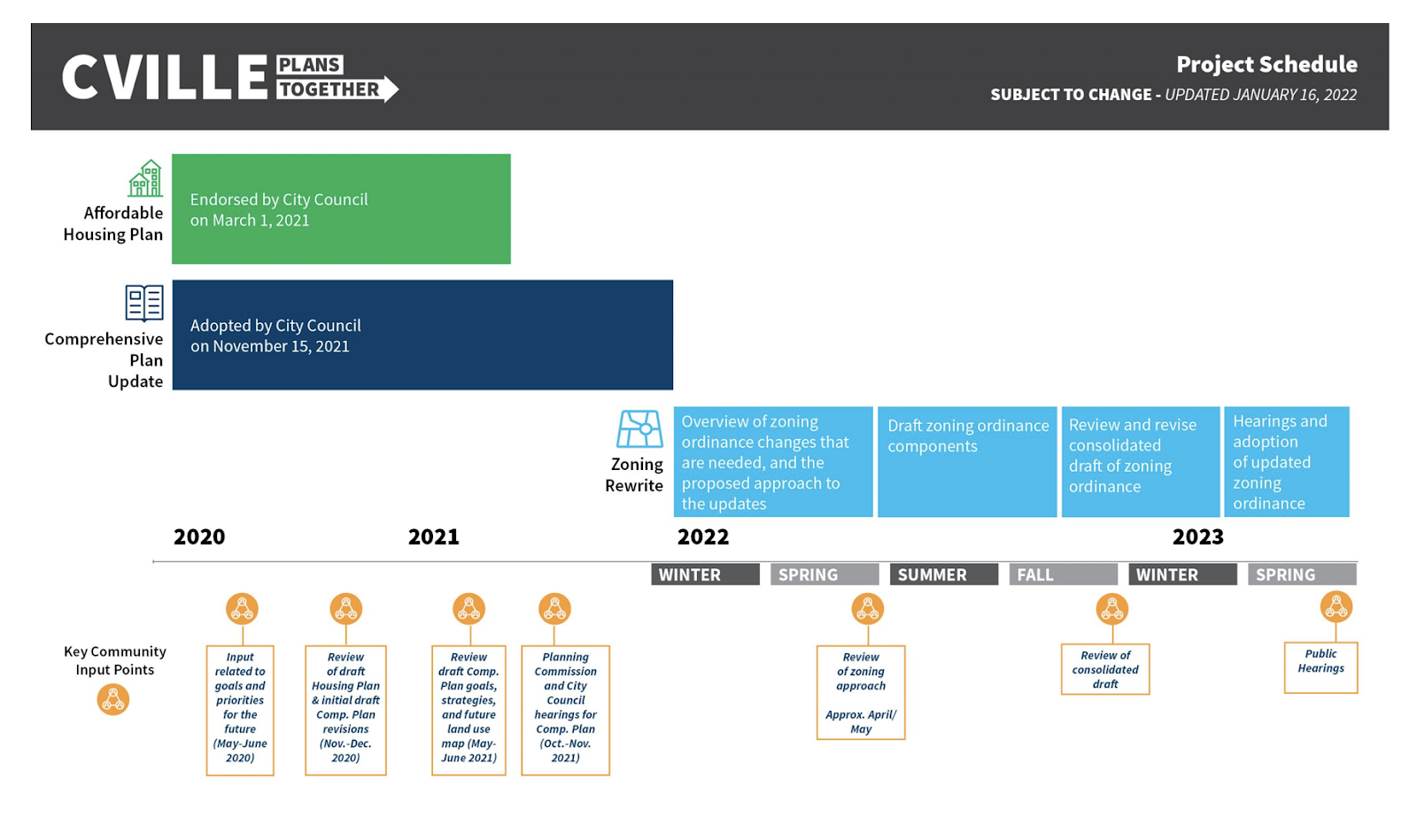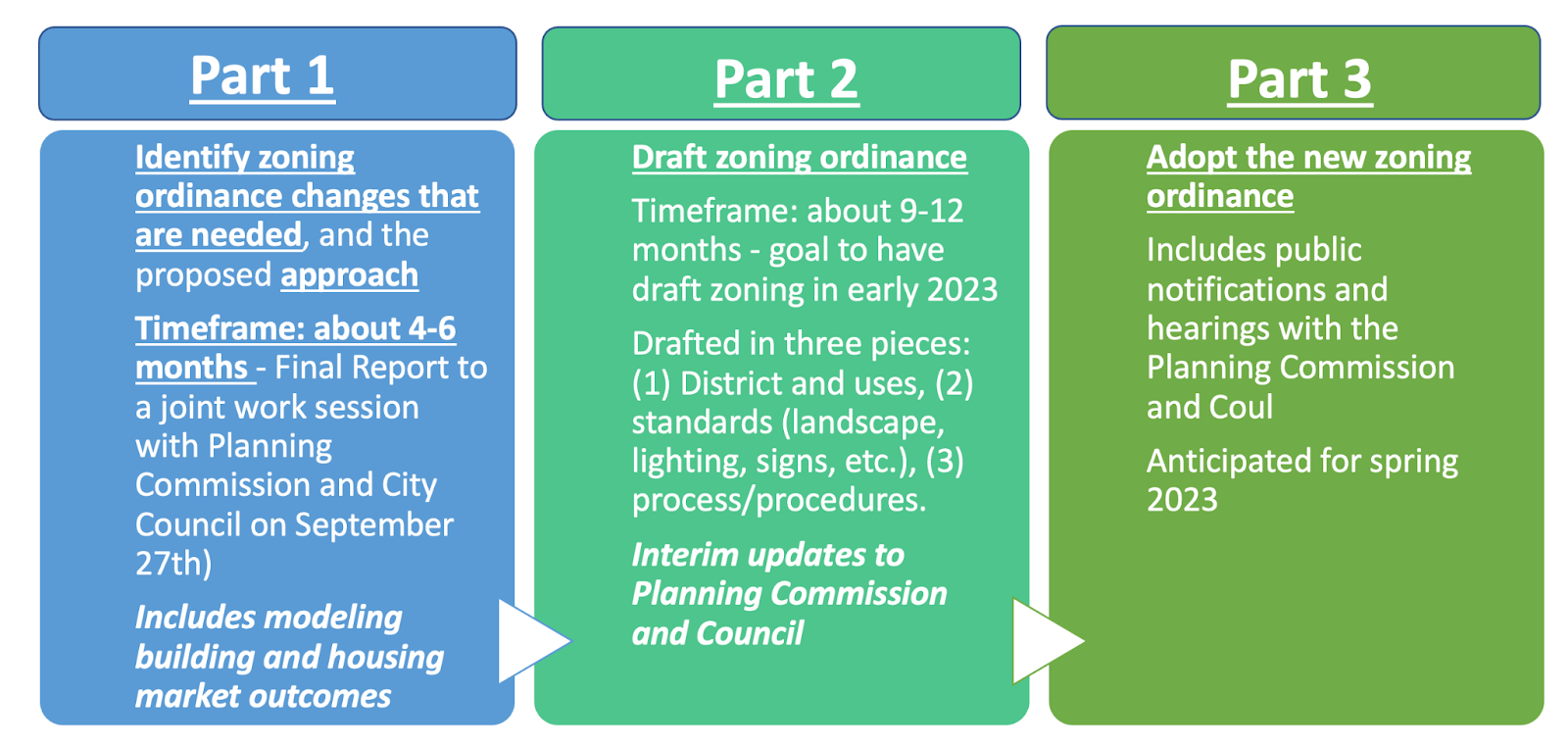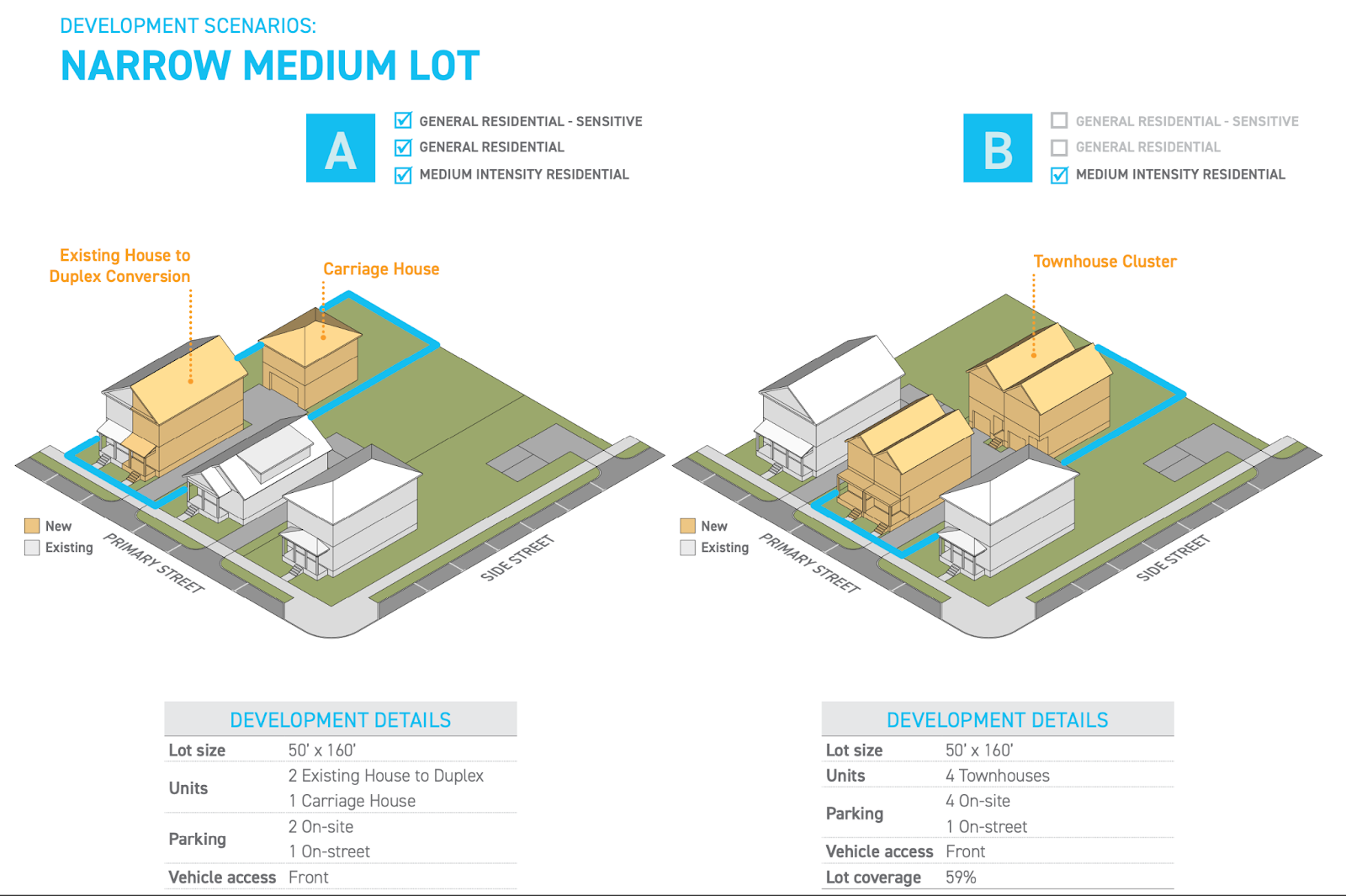Article by Wyatt Burttschell and Peter Krebs

The City of Charlottesville is in the third and final phase of the Cville Plans Together process: updating its zoning ordinance. Drafting that important document will take place this fall, but the groundwork is being laid right now. We would like to share more details about what is underway and how you can get involved.
In March 2021, the City adopted an Affordable Housing Plan, and in November 2021, a Comprehensive Plan. The zoning code is arguably the most important piece, and will most directly impact people’s lives because it governs what actually can and cannot be built, and where. The other two documents are aspirational whereas this one has direct real-world implementation.
In an effort to be extra-transparent, the City released an extraordinarily detailed draft Zoning Diagnostic + Approach Report. This draft document outlines many practical and tangible ways to correct existing flaws in the existing code, especially to improve conditions for affordable housing and to make the code easier for builders and residents to use.
PEC has been supportive of the process to date. We believe that infill and increased density within cities and towns, paired with improved livability, connectivity, and easy access to the outdoors is essential if we are to limit sprawl and preserve rural areas. This approach will also reduce vehicle trips, enable effective transit, improve community health and is essential if we are to get ahead of climate change. Making this all work will be a tall order and whether or not it succeeds will depend on the details. That’s why we’re paying close attention and think you should too.

An Overview of the Diagnostic Report
The report has three main sections: 1) zoning tools that can improve affordability; 2) a housing test assessing which infill housing types are possible and appropriate for various residential land use areas and lot types; and 3) a final section entitled “Better Zoning Standards” with 70 recommendations to reform current zoning.
Given the depth of information contained in each section of the report, we would like to highlight just a few of the promising and important aspects covered. We invite you to read the full report yourself, but a heads up: it’s a little confusing.
Affordability
An Inclusionary Zoning (IZ) policy is being proposed as a better way to bring about affordability than the current approach, which relies on rezoning proffers and special use permit conditions to produce affordable homes. The affordable housing plan describes the current practice as time-consuming and ultimately ineffective. An inclusionary zoning policy would be established for developments of a certain size and delicately balance market rate needs by offering incentives such as density bonuses to developers providing affordable housing.
Update: Read Cville Plans Together’s stand-alone report on the potential for Inclusionary Zoning in Charlottesville.
If you are interested in more details regarding inclusionary housing and zoning, please visit the link to an American Planning Association memo here.
The new zoning aims to limit displacement by designating “sensitive community areas” through a zoning overlay district. By using what is called the “Right of First Refusal,” the City could purchase for-sale properties which are currently affordable and to preserve that existing housing stock. The City has also commissioned a housing market analysis, which lays out what it would take, from a market perspective, for affordable housing to actually get built.
Housing Lot Test/Residential District Testing

The City’s newly adopted Comprehensive Plan fundamentally changes residential zoning by replacing the “R1” single-family designation with a more flexible “General Residential,” which will allow a variety of “house sized” options. These could include up to four units in various configurations (such as cottages and carriage houses). Certain other lots are designated “Medium Intensity,” on which more intense (but still house-sized) options would be allowed, such as townhomes, du- or tri- or quadplexes. The zoning code will articulate how this would work.
In order to see what infill residential options might look like, the consultant developed a model to evaluate various housing scenarios for typical block patterns and lot sizes. The test used six common lot types and 15 housing types and tested out which combinations would be likely to work. The report is rich in visual illustrations, demonstrating what context-sensitive housing would be possible. It’s worth checking out (the residential section starts on page 19 of the report).
Better Zoning Standards
The diagnostic report also proposes a host of technical recommendations, a few of which include:
- Consolidate mixed-use categories
- Allow setbacks that account for average surroundings
- Focus on form, not use
- Allow more development by-right with clearer standards
- Allow half stories, be clear about what constitutes a story, clarify height measurement standards
- Limit windowless walls facing sidewalks
- Replace the term “family” with “household” or “unit”
- Allow manufactured housing
- Promote urban agriculture
- Allow auxiliary commercial units, with clear definitions, in residential areas
- Reduce parking minimums and increase bike storage requirements
- Treat critical slopes as engineering issues, not zoning (we’re concerned about this one)
- Provide bonuses for the retention of existing buildings
- Eliminate the Entrance Corridor review by the Planning Commission; (the Planning Commission has asked that it instead be performed by the Architectural Review Board.)
- Use plain English and diagrams
- Make the zoning code digital-friendly
There is a great summary on pages 78-83 of the report.
What’s Next
Cville PlansTogether will summarize public comments at a Joint City Council/Planning Commission meeting on September 27. The actual writing of a zoning code will begin after that and a draft should be available for public review by the end of this year. We will follow the process throughout and share an update when the draft is ready for review.
PEC’s Albemarle & Charlottesville Community Organizer Peter Krebs is on the steering committee and he has been following the process closely throughout. He will be in touch with more information when it is available.
Opportunities to Learn More and Provide Input
Cville PlansTogether is accepting public comment on the Diagnostic Report via a survey (surveymonkey.com/r/Cville4), by email (engage@cvilleplanstogether.com) or through the website (cvilleplanstogether.com/contact-us/) through the end of August. Update: the deadline for comments has been extended to September 8.
There are three upcoming public meetings with some opportunities to submit comments:
Cville Plans Together Steering Committee Meeting
Monday, August 29, 5:30 p.m.
Online via Zoom (register)
There will be some limited time for public comment at the end.
Livable Cville Webinar (highly recommended)
Wednesday, August 31, 5:30 p.m.
Online via Zoom (register)
Our partners at Livable Cville have done a terrific job of explaining this process so far. Note, however, that this webinar is on the final day for public comment.
Joint City Council + Planning Commission Work Session
Tuesday, September 27, 5 p.m. (hybrid meeting)
Learn more on the website.
If you haven’t already, you can sign up for our email alerts today! You can also find PEC on Facebook, Twitter and Instagram. Remember that community support allows PEC to continue its work.
